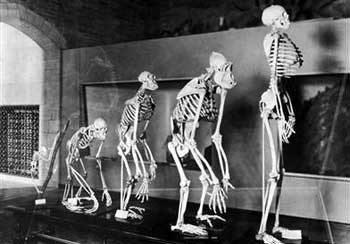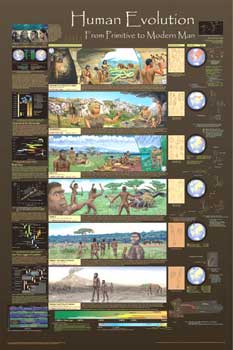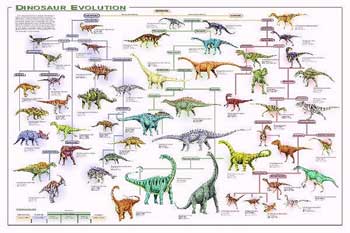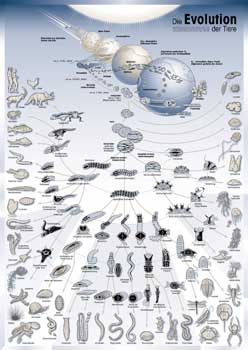Biological evolution is descent with modification. This definition
encompasses small-scale evolution (changes in gene frequency in a
population from one generation to the next) and large-scale evolution
(the descent of different species from a common ancestor over many
generations). Evolution helps us to understand the history of life.
While evolution is very widely accepted, many people hold to
misconceptions about it. This list should help to dispel some of those
myths.
 15. Evolution is a theory about the origin of life
15. Evolution is a theory about the origin of life
The theory of evolution primarily deals with the manner in which life has changed
after
its origin. While science is interested in the origins of life (for
example the composition of the primeval sludge from which life might
have come) but these are not issues covered in the area of evolution.
What is known is that regardless of the start, at some point life began
to branch off. Evolution is, therefore, dedicated to the study of those
processes.
14. Organisms are always getting better

While it is a fact that natural selection weeds out unhealthy genes
from the gene pool, there are many cases where an imperfect organism
has survived. Some examples of this are fungi, sharks, crayfish, and
mosses – these have all remained essentially the same over a great
period of time. These organisms are all sufficiently adapted to their
environment to survive without improvement.
Other taxa have changed a lot, but not necessarily for the better.
Some creatures have had their environments changed and their
adaptations may not be as well suited to their new situation. Fitness
is linked to their environment, not to progress.
13. Evolution means that life changed ‘by chance’
In fact, natural selection is not random. Many aquatic animals need
speed to survive and reproduce – the creatures with that ability are
more suited to their environment and are more likely to survive natural
selection. In turn, they will produce more offspring with the same
traits and the cycle continues. The idea that evolution occurs by
chance does not take the entire picture in to account.
12. Natural selection involves organisms ‘trying’ to adapt

Organisms do not “try” to adapt – it is natural selection that
enables various members of a group to survive and reproduce. Genetic
adaptation is entirely outside of the power of the developing organism.
11. Natural selection gives organisms what they ‘need.’
Natural selection has no “intelligence” – it can not tell what a
species needs. If a population has genetic variants that are more
suited to their environment, they will reproduce more in the next
generation and the population will evolve. If a genetic variant is not
present, the population will most likely do – or it will survive with
little evolutionary change.
10. Evolution is ‘just’ a theory

Scientifically speaking, a theory is a well substantiated idea that
explains aspects of the natural world. Unfortunately other definitions
of theory (such as a “guess” or a “hunch”) cause a great deal of
confusion in the non-scientific world when dealing with the sciences.
They are, in fact, two very different concepts.
9. Evolution is a Theory in Crisis
There is no debate in science as to whether or not evolution
occurred – there is, however, debate over how it happened. The minutiae
of the process is vigorously debated which can cause anti-evolutionists
to believe that the theory is in crisis. Evolution is sound science and
is treated as such by scientists worldwide.
8. Gaps in the Fossil Record Disprove Evolution

Actually, many transitional fossils do exist – for example, there
are fossils of transitional organisms between modern birds and their
dinosaur ancestors, as well as whales and their land mammal ancestors.
There are many transitional forms that have not been preserved, but
that is simply because some organisms do not fossilize well or exist in
conditions that do not allow for the process of fossilization. Science
predicts that there will be gaps in the record for many evolutionary
changes. This does not disprove the theory.
7. Evolutionary Theory is Incomplete
Evolutionary science is a work in progress. Science is constantly
making new discoveries with regard to it and explanations are always
adjusted if necessary. Evolutionary theory is like all of the other
sciences in this respect. Science is always trying to improve our
knowledge. At present, evolution is the only well-supported explanation
for all of life’s diversity.
6. The Theory is Flawed

Science is an extremely competitive field – if any flaws were
discovered in evolutionary theory they would be quickly corrected. All
of the alleged flaws that creationists put forth have been investigated
careful by scientists and they simply do not hold water. They are
usually based on misunderstandings of the theory or misrepresentation
of the evidence.
5. Evolution is not science because it is not observable
Evolution
is observable and testable. The confusion here is
that people think science is limited to experiments in laboratories by
white-coated technicians. In fact, a large amount of scientific
information is gathered from the real world. Astronomers can obviously
not physically touch the objects they study (for example stars and
galaxies), yet a great deal of knowledge can be gained through multiple
lines of study. This is true also of evolution. It is also true that
there are many mechanisms of evolution that can be, and are studied
through direct experimentation as with other sciences.
4. Most Biologists have rejected Darwinism

Scientists do not reject Darwin’s theories, they have modified it
over time as more knowledge has been discovered. Darwin considered that
evolution proceeds at a deliberate, slow pace – but in fact it has now
been discovered that it can proceed at a rapid pace under some
circumstances. There has not been, so far, a credible challenge to the
basic principles of Darwin’s theory. Scientists have improved and
expanded on Darwin’s original theory of natural selection – it has not
been rejected, it has been added to.
3. Evolution Leads to Immoral Behavior
All animal species have a set of behaviors that they share with
other members of their species. Slugs act like slugs, dogs act like
dogs, and humans act like humans. It is preposterous to presume that a
child will begin to behave like another creature when they discover
that they are related to them. It is nonsensical to link evolution to
immoral or inappropriate behavior.
2. Evolution Supports “Might Makes Right”

In the 19th and early 20th century, a philosophy called “Social
Darwinism” sprung up from misguided attempts to apply biological
evolution to society. This philosophy said that society should allow
the weak to fail and die, and that not only is this an ideal situation,
but a morally right one. This enabled prejudices to be rationalized and
ideas such as the poor deserved their situation due to being less fit
were very popular. This was a misappropriation of science. Social
Darwinism has, thankfully, been repudiated. Biological evolution has
not.
1. Teachers Should Teach Both Sides
There are tens of thousands of different religious views concerning
creation. It is simply impossible for all of these views to be
presented. Furthermore, none of the theories are based in science and
therefore have no place in a science classroom. In a science class,
students can debate where a creature branched off in the tree of life,
but it is not right to argue a religious belief in a science class. The
“fairness” argument is often used by groups attempting to inject their
religious dogmas in to the scientific curricula.























































